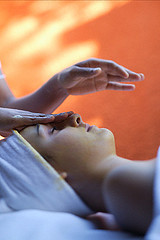Massage Basics
Massage Preparation:

It is not a good idea to give a massage if you are stressed or tense or if you are not in full health, as your energy levels will be depleted. Both before and during the treatment, be aware of your breathing but do not try to change it. Wear comfortable footwear and clothes. Choose something with short sleeves or roll them up out of the way. Take off any noisy jewellery, which can be very distracting, and remove your watch and any rings. You cannot massage with long nails, and rough skin will feel very abrasive, so get out the nail clippers and hand cream. If you have long hair, tie it back to avoid it distracting either of you. Remember that you will be working very close to your partner, so if you have recently indulged in strong-flavoured food or drink use a mouthwash or breath freshener.
The Giver:
You must choose actively to give your time to someone. If your mind is elsewhere, your partner will sense this and the massage will not be pleasurable for either of you. Care, sensitivity and respect are very important requirements, so your mind should be freed up to give your partner your full attention.

The Reciever:
It is often much more difficult to receive massage than to give: the ability to trust and let go sometimes also has to be learned. Be receptive to the touch, allow the giver to move your limbs for you when required, and let them know if anything is uncomfortable or when a stroke is particularly effective. Sometimes massage can release pent-up emotions. If this happens, there is nothing wrong – do not fight the feelings or become embarrassed, but simply let them go. Before the massage begins, remember to take off all your jewellery, including earrings, and if you are wearing contact lenses you may prefer to remove them for comfort and safety, especially if the giver is going to work on your head and face. With close friends and family, the receiver maybe happy to undress to underpants; otherwise, only the areas of the body that are being worked on need be exposed at any one time. The ideal is to work free of clothing restrictions, but the massage environment is not always appropriate for this. As with the giver, do not forget that fresh breath is a must, so use a mouthwash before receiving your massage.
When Not To Massage:

In general, massage is safe. Trained therapists are able to treat everyone from premature babies to the terminally ill, but if any of the following apply, you should not massage, or should take care as directed below:
1.Anyone weak or clinically exhausted – for example, suffering or recovering from a viral infection.
2.Anyone who has a high temperature or is suffering from a contagious disease.
3.Anyone who has infectious skin complaints, such as scabies, herpes and warts.
4.Anyone who has a serious medicinal condition such as cancer, heart disorders or thrombosis.
5.Do not massage the site of a recent fracture, strain or sprain. In these cases work one joint above.
6.Do not massage directly where there are skin surface problems, such as scar tissue, bruising, tender or inflamed areas and varicose veins. You can, however, work with care above the site and, of course, on other unaffected parts of the body.
7.Do not massage during the first trimester of pregnancy and thereafter avoid very deep pressure, particularly on the lower back and inside leg from ankle to groin.
8.After surgery, wait for 12 months following major operations and six months following minor procedures. Scar tissue should then be fully healed, but if in doubt seek medical practitioner approval.
It is advisable to recieve massage if you have recently eaten a heavy meal or have drinking quantities of alcohol, as they will make the experience very uncomfortable and may produce unpleasant after-effects. The general rule is to trust your own judgement and common sense and, if in any doubt, check with a doctor.